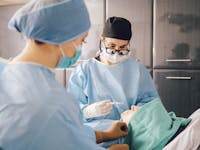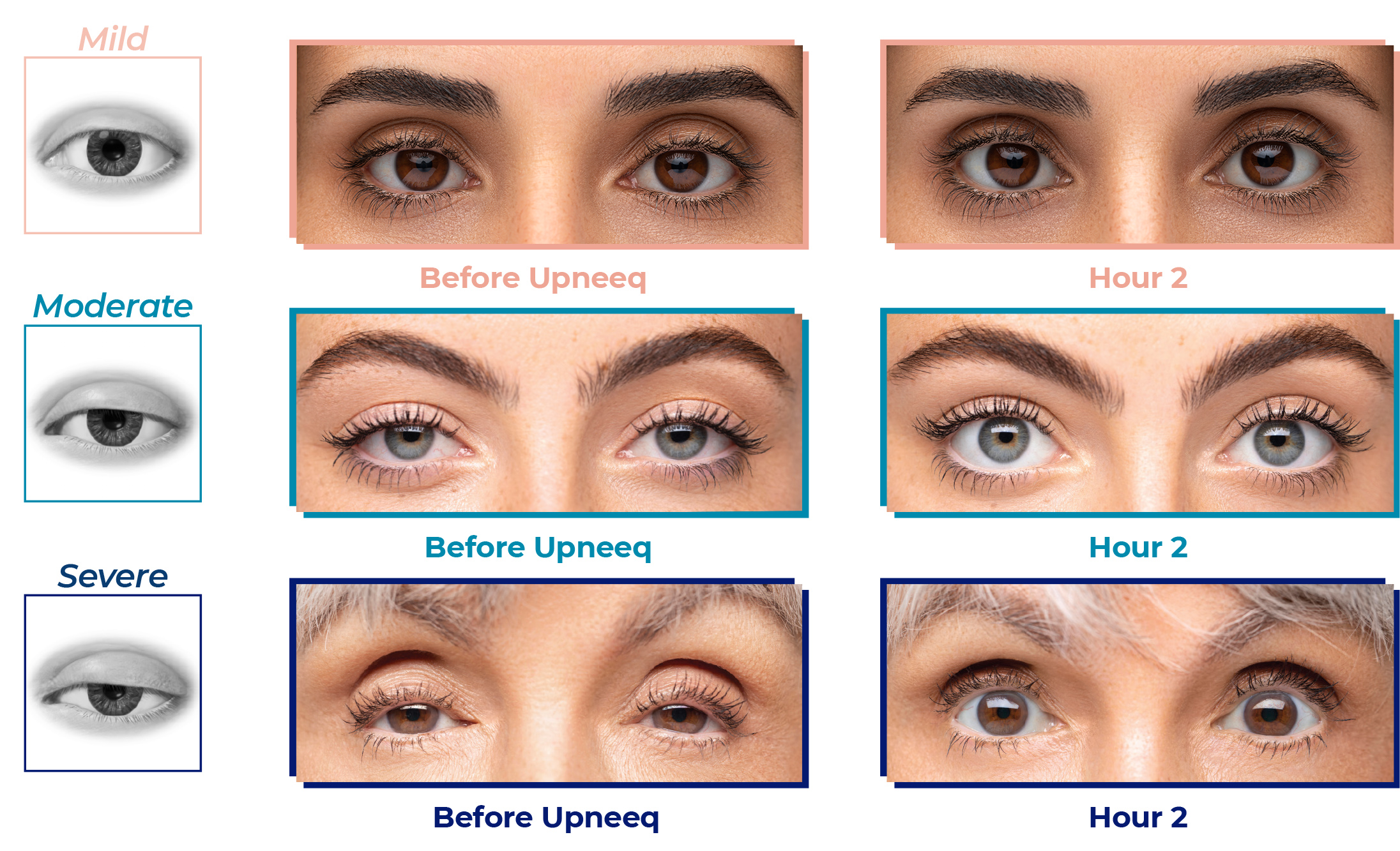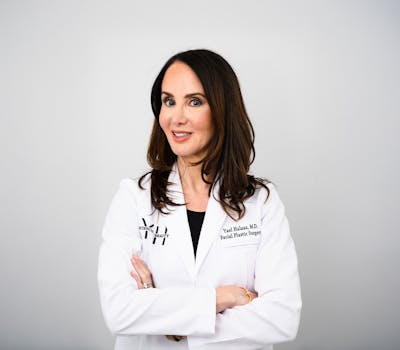Blepharoplasty
Before and after images of a patient who received upper blepharoplasty surgery.
View GalleryDr. Yael Halaas brings over 20 years of expertise in facial plastic surgery, specializing in eyelid surgery in NYC. Known for achieving high patient satisfaction and maintaining low complication rates, Dr. Halaas is recognized as a leader in her field. As a double board-certified surgeon in Otolaryngology and Facial Plastic and Reconstructive Surgery, she blends artistic vision with advanced surgical techniques to deliver natural, youthful results. With training from prestigious institutions like Columbia and Cornell, Dr. Halaas is celebrated for her compassionate approach, ensuring patients feel confident and well-cared for throughout their eyelid surgery journey.

Blepharoplasty, commonly called eyelid surgery, addresses sagging skin on or around the eyelids to tighten and rejuvenate the eyes, achieving a younger, refreshed, and more appealing appearance. Different types of eyelid surgery are designed to focus on the upper eyelids or lower eyelids. These procedures can also be performed at the same time for patients who require both eyelids to be addressed.
Blepharoplasty
Before and after images of a patient who received upper blepharoplasty surgery.
View GalleryBlepharoplasty
Before and after images of a patient who received upper blepharoplasty surgery.
View GalleryBlepharoplasty
Before and after of a patient who received an upper and lower blepharoplasty.
View GalleryUpper eyelid surgery is performed to address loose, drooping skin on and around the upper eyelids, that cause a hooded, tired, or older appearance.
Upper Eyelid Surgery »Lower eyelid surgery is performed to smooth puffy bags and fill dark circles under the eyes to create a more youthful contour.
Lower Eyelid Surgery »Asian eyelid surgery is a procedure designed to create a fold in the upper eyelid and/or reduce excess tissue along the eyelids. Asian eyelid surgery maintains cultural identity while reducing vision impairment and improving the definition and size of the eyes.
Eyelid surgery provides many benefits for patients who would like to improve the appearance of their eyelids. Benefits of eyelid surgery include the following:
Patients who are not happy with the appearance of their eyes or who would like to reduce sagging, drooping skin may be candidates for this eyelid surgery. Dr. Halaas will consult with you to examine your eyes and discuss your aesthetic concerns and goals. From this consultation, you will determine whether you are an ideal candidate for this procedure. Candidates generally meet the following requirements:

As a part of preparing for your eyelid surgery in NYC, Dr. Halaas will provide a list of medications to avoid, including aspirin and other anti-inflammatory medications or supplements. You will also need to arrange for a friend or family member to drive you home and help you during the first day of your recovery.
Dr. Halaas will perform your eyelid surgery in NYC under local anesthesia. If you prefer general anesthesia, she will arrange this. Once the anesthesia has taken effect, Dr. Halaas will make a small incision in the natural crease of the upper or lower eyelid, which will eventually heal into virtually imperceptible scars. In some cases, Dr. Halaas can make the incision inside the lower eyelid to completely eliminate scarring.
During lower eyelid surgery, she will tighten the ligaments of the lower eyelid, and reposition and contour the fat pouches that are causing puffiness and bags. This achieves a more youthful, smooth undereye appearance. The incision is closed with biological glue or absorbable sutures.
During upper eyelid surgery, Dr. Halaas will remove the excess, loose skin and tighten the eyelids, creating a refreshed, renewed, and appealing appearance. The incision is closed with absorbable sutures or biological glue.
To support healing, sleep on your back with your head elevated, avoid bending or strenuous activity for at least 2–4 weeks, and wear sunglasses to protect the area from sun exposure. You may wear glasses the next day, but wait 10–14 days before using contact lenses.
Avoid eye makeup and screen strain for several days. Lubricating drops and gentle incision care may be recommended. Most patients see early results within two weeks, with final results visible by six weeks.
The recovery process is gradual, and while discomfort is minimal, it’s important to follow the recommended aftercare to ensure the best outcome. A follow-up appointment will be scheduled to check your healing progress. Most patients report feeling like themselves again after just a few weeks, with a refreshed, youthful appearance that continues to improve over time.
Combining procedures with eyelid surgery can enhance overall facial rejuvenation by addressing multiple areas simultaneously. Dr. Yael Halaas can recommend the following surgical and non-surgical options available to complement eyelid surgery:
Droopy upper eyelids can also be addressed non-surgically with Upneeq, an advanced eyedrop treatment that opens your eyes, slightly improves your field of vision, and provides a more youthful appearance without a surgical procedure. While Upneeq doesn’t provide the significant change that a surgery can, the results are noticeable and provide a cosmetic and medical benefit.
Upneeq is the first and only FDA-approved prescription eye drop that is clinically proven to lift and tighten drooping upper eyelids. The active medication called oxymetazoline hydrochloride works by contracting the Muller’s muscle in the eyelid, causing the eyelid to become shorter and tighter.
Upneeq eye drops are applied once a day, one drop per eye, providing results very shortly afterward, which are effective for at least 6 hours.

As a double board-certified plastic surgeon in Otolaryngology and Facial Plastic and Reconstructive Surgery, Dr. Yael Halaas has two decades of experience in facial plastic surgery procedures such as eyelid surgery.
Dr. Halaas is the number one female facial plastic surgeon in NYC. Her combined artistic sensibility and expertise in the latest surgical techniques make her an authority in the field. She is a trusted opinion leader as a facial plastic surgeon who has performed hundreds of successful eyelid surgeries for satisfied patients.
Dr. Halaas’ understanding and compassionate bedside manner balance well with her safe, cutting-edge surgical skills. Patients trust her honest, empathetic manner and professional skill. If you would like to know more about blepharoplasty in NYC, we invite you to contact us about a consultation with Dr. Halaas.

Upper eyelid blepharoplasty, removes excess skin and fat that can cause drooping eyelids. By addressing these issues, the procedure can create a more open and alert eye appearance, contributing to a youthful look. However, the surgery doesn't physically enlarge the eyes but enhances their visibility and contour.
Yes, when sagging upper eyelid skin obstructs the visual field, upper blepharoplasty can be medically necessary to remove the excess tissue, thereby improving peripheral vision.
Most patients can return to light activities within a week post-surgery. However, it's advisable to avoid strenuous exercises, heavy lifting, and activities that increase blood pressure for at least 2 to 4 weeks to ensure proper healing and minimize swelling.
The results of lower eyelid blepharoplasty are typically long-lasting and often considered permanent. Upper eyelid surgery results can last between 5 to 7 years, depending on individual aging processes and lifestyle factors. Maintaining a healthy lifestyle can help prolong the benefits of the surgery.
Dermal fillers, Botox, laser skin resurfacing, IPL, chemical peels, and microneedling can all help refresh the eyes.
Eyelid surgery carries the risks of any surgical procedure, including bleeding, infection, blood clots, scarring, unfavorable outcome (eyelid problems), anesthesia risks, and others.
Yes, combining upper and lower blepharoplasty in a single surgical session is common and can provide comprehensive rejuvenation of the eye area. This approach also consolidates recovery time and can be more cost-effective.
Initial improvements are noticeable within a few weeks post-surgery as swelling and bruising subside. However, the final results typically become evident after 6 weeks, with continued subtle improvements over several months.
The surgery usually takes between 1 to 2 hours, depending on whether both upper and lower eyelids are addressed and if additional procedures are performed concurrently.
Most patients can safely resume wearing contact lenses about 1 to 2 weeks after blepharoplasty, depending on how quickly your eyelids heal. It's important to wait until any swelling, bruising, and irritation have significantly subsided, and Dr. Halaas gives you the go-ahead. Wearing contacts too soon can strain the healing tissue and increase the risk of complications.
Blepharoplasty is generally associated with minimal discomfort. Patients may experience mild soreness or tightness around the eyes, which can be managed effectively with prescribed pain medications or over-the-counter analgesics.
Dr. Halaas ensures any exterior incisions are carefully concealed in the natural eyelid crease.
If sagging upper lids or puffy under-eyes are making you look tired or older than you feel, a custom eyelid surgery with Dr. Halaas can help restore a refreshed, youthful appearance. Whether you’re considering upper eyelid surgery, lower eyelid correction, or both, our team is here to guide you through the process with skill, compassion, and clear communication.
Let’s bring out the best in your eyes. Contact us today to schedule your consultation and take the first step toward a more confident, refreshed you.
© Yael Halaas MD. All Rights Reserved.